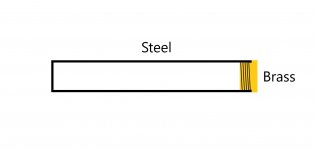Jimbob 2705
Plastic
- Joined
- Aug 21, 2017
Best way to remove brass plug from steel tube...
Hi Folks,
Apologies if this is the incorrect section, not too sure where to put it.
After some advice on the best way to remove the brass end plug which is threaded into a steel tube.
A few things worth mentioning :
The steel tube is of a relatively tough powdercoated finish. Whilst relatively thick wall, it is important it doesn't get damaged/squashed when holding.
The other end of the tube is solid so no way to get penetrating oil, etc down to the threads.
Brass end plug is smooth (no flats for tools) but has a couple of of holes in the outside diameter, which a couple of pins locate in and can be unscrewed with a tool
I feel use of careful heat is the answer although being careful with the tube finish. Which part is best to heat and why? I suspect I could also use freeze spray to enhance contraction/expansion.
Attachment below of a very basic diagram.
Cheers chaps!

Hi Folks,
Apologies if this is the incorrect section, not too sure where to put it.
After some advice on the best way to remove the brass end plug which is threaded into a steel tube.
A few things worth mentioning :
The steel tube is of a relatively tough powdercoated finish. Whilst relatively thick wall, it is important it doesn't get damaged/squashed when holding.
The other end of the tube is solid so no way to get penetrating oil, etc down to the threads.
Brass end plug is smooth (no flats for tools) but has a couple of of holes in the outside diameter, which a couple of pins locate in and can be unscrewed with a tool
I feel use of careful heat is the answer although being careful with the tube finish. Which part is best to heat and why? I suspect I could also use freeze spray to enhance contraction/expansion.
Attachment below of a very basic diagram.
Cheers chaps!

Last edited:

